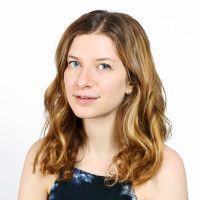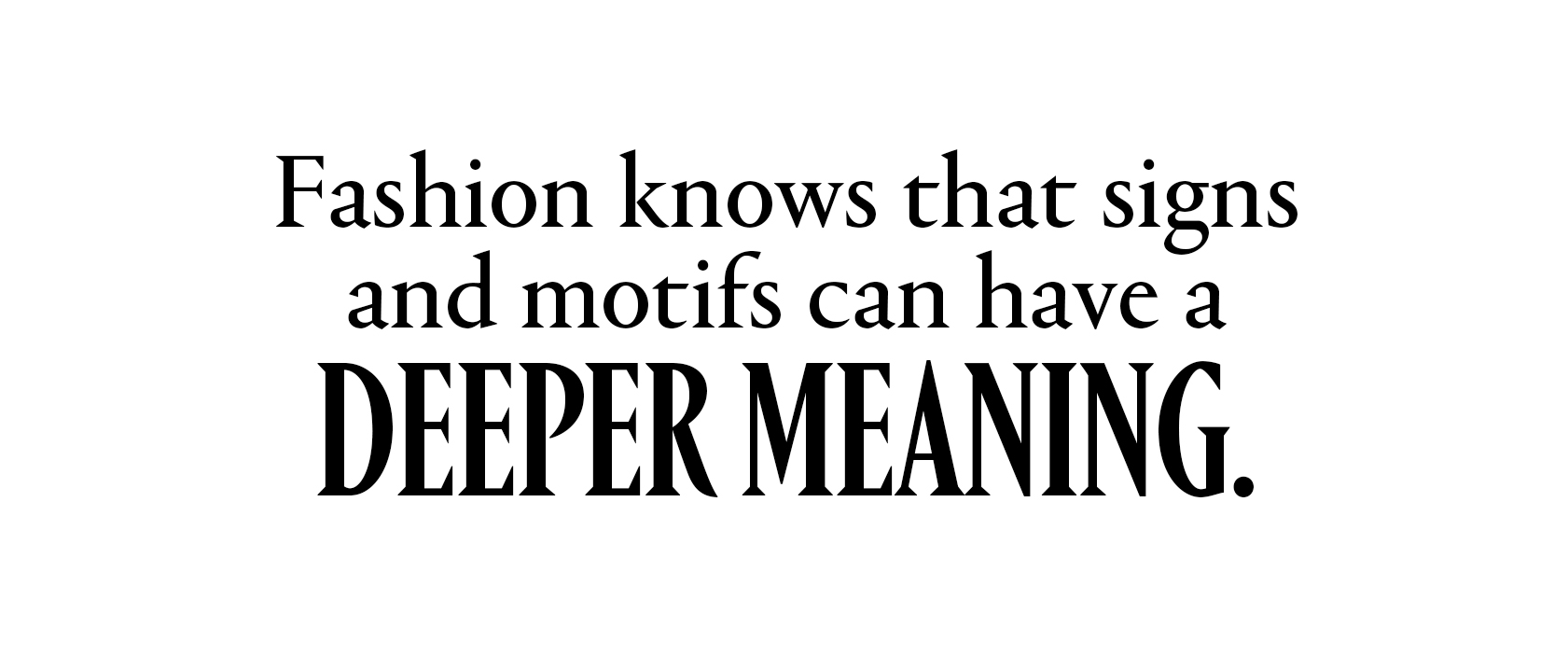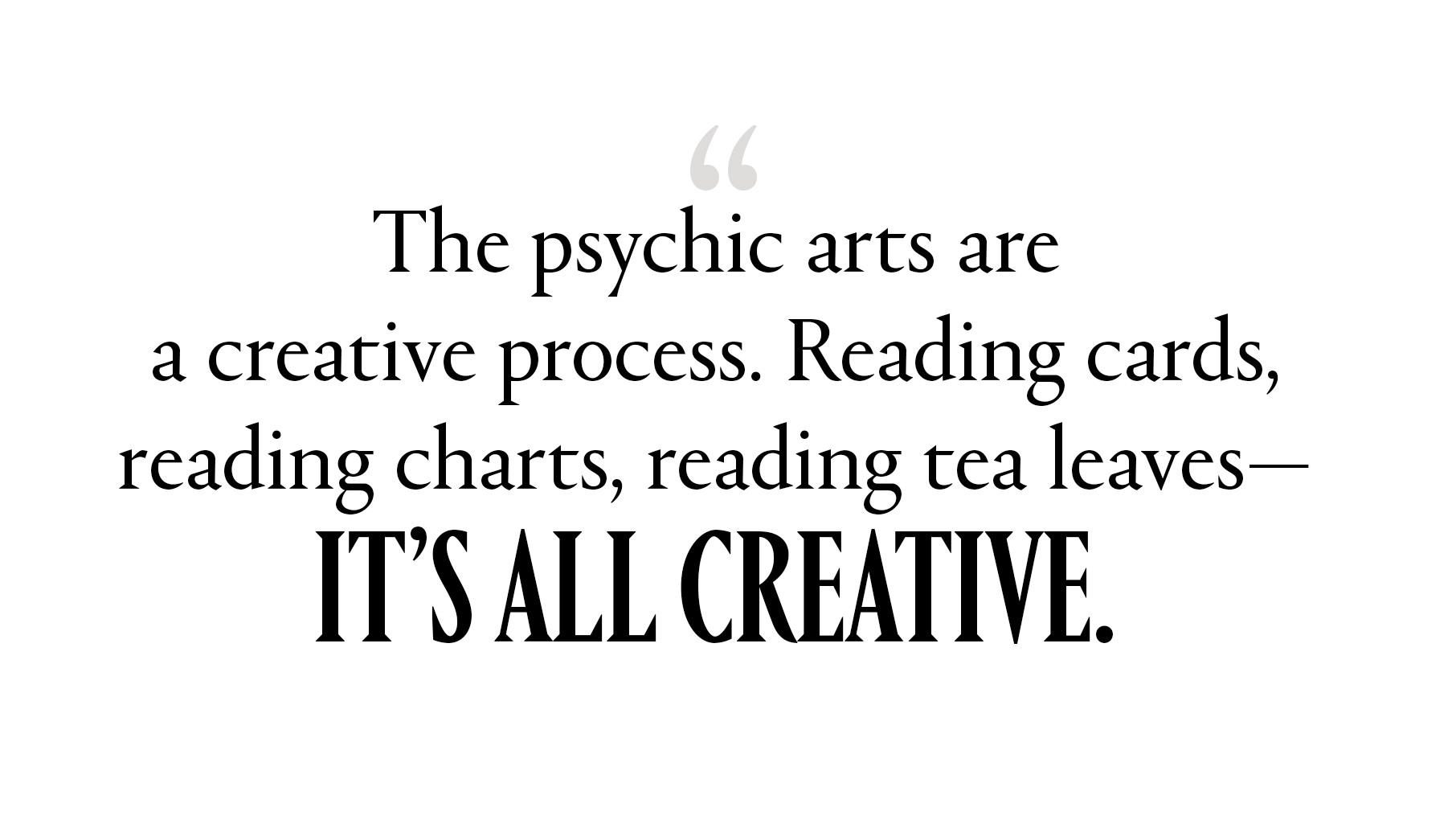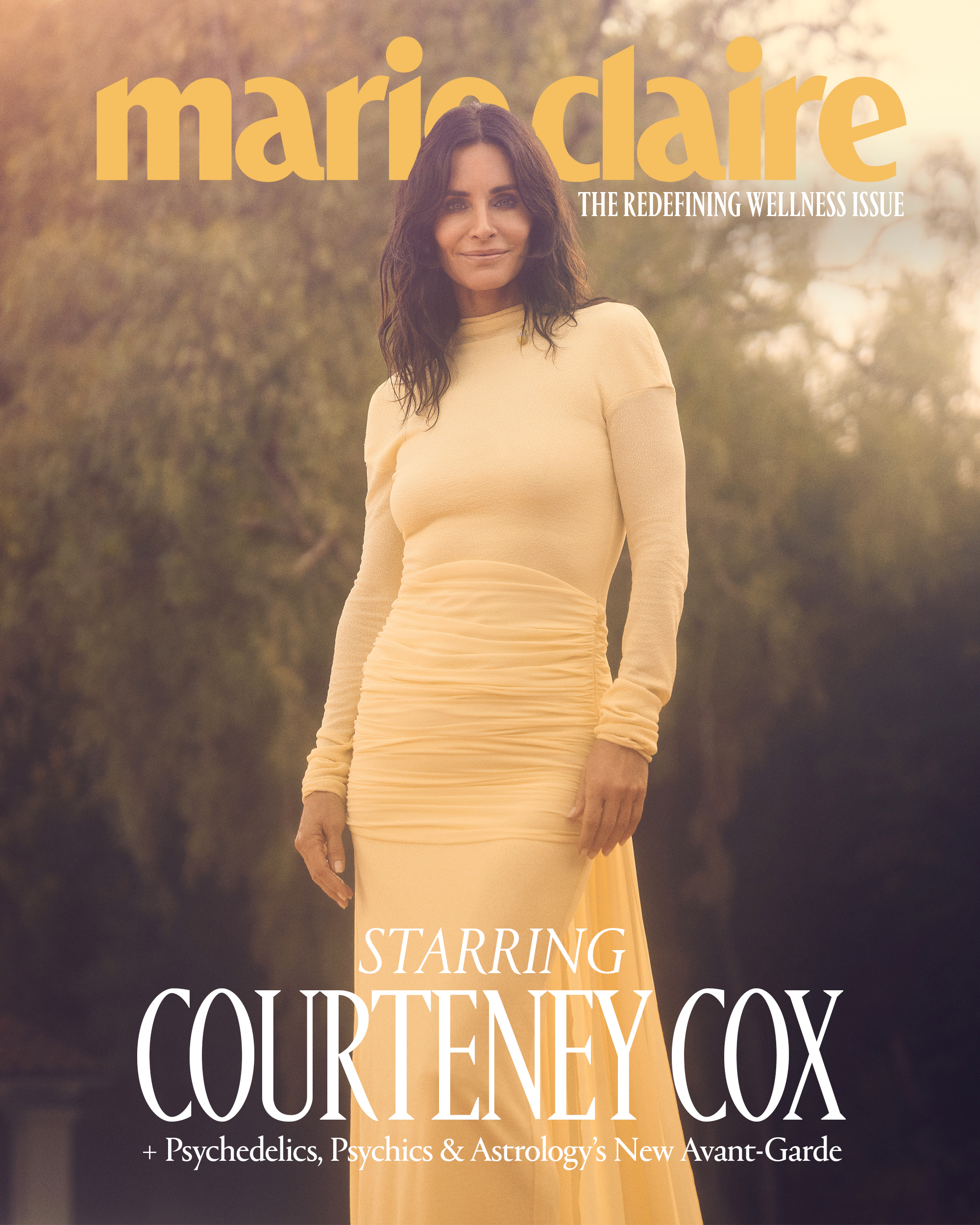Fashion Sees the Future
Turns out, predicting what everyone will be wearing months from now requires a little bit of magic. Psychics, mediums, and astrologers help, too.


Lucy Akin’s friend just had this hunch. (Should we call it a vision?) The friend had met an astrologer and he seemed talented. “He’s not really for me,” she told Akin. “But I feel like you would love him.”
“He gives me you vibes,” she added.
Akin was in the market. Since entering the workforce in 2010, she’d pursued a career in fashion. She had longed to be a designer, but fell into the steadier side of the business—first assisting, and then joining, the beloved and now-shuttered Satine, a boutique she kept stocked with brands like Alaïa, Balenciaga, and Valentino. At one point, Akin opened her own store and called it Shop Super Street, but the hustle exhausted her and she craved more tangible creative expression.
That kind of ennui drives some people to make an appointment with a therapist. It spurs marathon training, watercolor painting, even a meditation habit. But Akin didn’t want new hobbies or to lie on a licensed clinical social worker’s couch. She was after a more cosmological brand of guidance.
When the recommended astrologer showed up, Akin encountered a six-foot-four-inch tall British man, dressed in khaki shorts, camper socks, and thick glasses, wearing about a “million” necklaces around his neck. He didn’t ask Akin’s name. He didn’t introduce himself. (His name is Nigel.) He just parked himself on Akin’s deck and said, “Why aren’t you designing?”
“It was like, okay, so I guess you know I work in fashion,” Akin remembers. Nigel was adamant—and harsh. “He was like, ‘Why are you buying other people’s brands? You’re doing the wrong thing.’” The rest of the session went on like that—a mix of support, vehemence, and haranguing. Akin started sketching not long after. She produced a small capsule collection, stocked the dresses in her store, and watched them sell out. Magazines began buzzing about the brand before Akin’s dresses even had care labels on them. She formalized the line in 2017 and named it Ciao Lucia. She’s been operating it—and seeing Nigel for regular check-ins—ever since. Ciao Lucia now sells at department stores and retailers like Bergdorf Goodman and Moda Operandi. Vogue called it the “cool girl’s answer to resortwear.” Its fans include Kaia Gerber, Gigi Hadid, and Margot Robbie.
No wonder Akin declares herself “a big psychic girl.” Her and the rest of the fashion world too.
Get exclusive access to fashion and beauty trends, hot-off-the-press celebrity news, and more.
For most of the modern era, fashion designers and spiritualists have been in divine communion. Both Coco Chanel and her rival Elsa Schiaparelli believed in the power of numbers. In fact, Schiaparelli married a conman who billed himself as “The World Famous Dr. W. de Kerlor.” The union didn’t last, but Schiaparelli’s interest in the heavens did. She produced a famed Zodiac couture collection—still a reference point for designers.
Meanwhile, the famed Christian Dior lined his office with fortune-telling cards and hired a clairvoyant named Madame Delahaye to predict the fate of his sister during World War II. Relatives were sure she’d died, but Delahaye said Catherine Dior—a French resistance fighter—had survived. When the seer was vindicated and Catherine did indeed arrive in France, she told Dior to set up his own couture house. He listened. Given Catherine’s miraculous return, it seemed fated. In his memoir, Dior wrote that he saw in his chosen business a hint of the paranormal. “In a century which attempts to tear the heart out of every mystery, fashion guards its secret well,” he penned, “and is the best possible proof that there is still magic.”

In the decades since, Donna Karan and Marc Jacobs have embraced the art of tarot. The down coat guru Norma Kamali is such a believer in the intuitive arts that she once hosted astrologers at her cafe in New York. Reports claim that Louis Vuitton has relied on a Brazilian “weather shaman” to clear the forecast in advance of outdoor shows. It was said that skeptics on the board balked at the shaman’s expenses—until a rainstorm washed out a Dior cruise show in 2018. After that, the shaman’s services were reportedly re-engaged.
But it’s not just practical matters that the fashion world is leaving in the hands of spiritualists. Madame Delahaye gave Dior his business plan. Designers now seem to want intuitives to function as something closer to creative directors—interpreters of their inspiration, curators of their vision boards, partners in their growth. Think: Less divine decision makers, more elite fitness trainers. If fitness trainers could reveal how the universe could be used to harness your goals.
Dante Sabatino—a tarot reader with three decades of experience whose reputation is so sterling New York Magazine once called out his knack for “startling” precision in his predictions—feels a natural rapport with the designers and retail impresarios for whom he reads. Both are in the forecasting business. “For them, there’s a storyboard related to a season, and tarot is a universal storyboard,” he says. Those in the fashion world, including Sabatino stalwarts like Morgane Le Fay designer Liliana Casabal and Gabriela Hearst, look at trends over time. So does he. Fashion knows that signs and motifs can have a deeper meaning. Sabatino has built his entire career on the same premise.
“The psychic arts are a creative process. Reading cards, reading charts, reading tea leaves—it’s all creative,” Sabatino says. “I’m looking at symbols and getting messages, and it’s the same thing with art and design. That kind of translation is similar. It’s just the expression that’s different.”

For Scott Sternberg, the creative force behind beloved and erstwhile labels Band of Outsiders and Entireworld, the relationship between his work and the work that people like Sabatino do is self-evident. “Fashion people are open-minded,” Sternberg points out. But it’s more than that. “At our best, whether you’re a visual artist or a movie director or an actor, when you have really good ideas—the best ideas, the big ideas—those are not ideas that you go to school to figure out how to come up with. Those are ideas that I have intuitively felt come from somewhere else. They just landed in front of me. And the timing was really good, and I was able to recognize it.”
When it comes to fashion and the supernatural, “it’s all divine,” Erika Gabriel, a spiritual medium who communes with “Divine Spirit Teams” and hosts a podcast called You Are Not Alone, tells me. “When you can open yourself up and be available to creative expression, that’s when all of that positive energy, spirit, God, all of that can come rushing in and you can open your mind, expand, and then create. Gabriel explains that she often works with actors and designers whose craft she identifies as a form of “mediumship as well.”

Several designers whom I speak to agree. Los Angeles-based jeweler Jacquie Aiche sells crystals and candles alongside fine necklaces, “sacred amulets” drawn from Kabbalistic traditions, and a slew of other talismans.
Spiritualism remains so central to her work that an intuitive named Sylvain Sellam is on staff. The two have collaborated on a collection of amulets called Blesslev. Their pieces retail for about $225 and each one contains both a “gratitude list” for the wearer to fill out and a kabbalistic mantra familiar to chanters the world over: “Na Nach Nachman Meuman.”
In addition to their Blesslev line, Sellam continues to do readings in her office. Even Aiche’s skeptical relatives will sometimes ask to come in for a blessing or a “cleaning.” Does it make a difference? Juice the bottom line? Aiche doesn’t question the particulars. All she knows is that “if it gets stagnant in here, we have a yoga room upstairs, and I’ll go, or I’ll work with a spiritual woman who does quantum physics, and we will shift the energy in the office, and the next thing you know, the following week, we’re in the backyard having a water balloon fight, and all the girls are having fun, and the sales are coming in.”
It occurs to me while we’re talking that whether Sellam is opening up a channel with the universe or just working as a divinely inspired organizational psychologist is a matter of perspective. But as far as Aiche is concerned, the man gets results. Of course, he would not be the first to realize that boosted morale tends to make for a happier and more productive workforce. No tea leaves required.
There isn’t an intuitive worth her salt who is going to promise all prosperity all the time. Carissa Schumacher—an intuitive medium and the author of The Freedom Transmissions, a book in which Schumacher transcribes her channeling of Yeshua, or Jesus Christ—describes her work as “realizing deeper peace, joy, abundance, and balance” in the lives of those with whom she works. It’s hardly moonbeams and rainbows. Seekers tend not to find her when things are going great.
Schumacher has a barebones website and no social media presence, but scores of people do track her down. Not all are famous, but a New York Times profile counted Jennifer Aniston, Uma Thurman, and Andie MacDowell among the attendees at an event in honor of her book. Aniston in particular has worked with her since 2019.
The designer Scott Sternberg was introduced to Schumacher through the actor Rooney Mara. He had emailed Mara at the start of the pandemic with a request: “Give me the best you’ve got.”
At the time, Sternberg was wondering whether he should wind down Entireworld—his line of super soft, colorful sweats. “I could not see a future for it,” he says. “And then the pandemic happened, and the brand—which had been doing just fine—took off.” He didn’t want to continue operating it, but he also couldn’t quite close it down just then. “There was an inflection point,” he says now.
Sternberg has had a lifelong interest in “the big questions” and has worked with intuitives of all kinds. He’s also lived in Los Angeles long enough to know that “actors have really, really good psychics.” Mara compiled a list of suggested mediums, one of whom was Schumacher. But she warned him. “Carissa was the one that would probably not write back, but if she did, and it might be in a year, it was like, ‘You’re lucky because she’s so special.’”

Sternberg emailed in March. The reading was set up for November. Sternberg and Schumacher have since become close. He’s attended several of her intensives, called Sacred Spirit Illumination Journeys. He can barely verbalize what he gets out of them, except he can absolutely explain why he is drawn to them. “It’s just an incredibly expansive time,” he says. “It takes you out of your narrow tunnel vision, which we all have to get into to get through the day.” He initially resisted the trips, but then: “I just sort of went with it. And that’s part of what Carissa helps you with—just understanding what part of your intuition is truly intuition and what part is fear or insecurity or ego.”
“I think the connection is there,” Sternberg continues, referring back to what creatives and the likes of Schumacher have in common. “Because the soup that she’s slurping is the same soup that we go to for that ultimate inspiration.”
Perhaps because of that essential act of, let’s call it imbibing, Schumacher chafes at the word “psychic.” Sternberg interprets. She does too.
“We all have free will and the probabilities of what one is to experience can be reorchestrated,” she writes in an email. “With regards to seeing things in the future, there are three types of visions that I receive for things that are or will be occurring in different areas of someone's life: Absolutes, High Probability, and Low Probability. Absolutes are quite rare. When I receive an Absolute, the vision feels very real, concrete, like it has already happened. High Probability visions are a little more hazy, but still have a high likelihood of manifesting if a person continues on the path they are on at the time. Low probability visions are almost vaporous, as if there is some but very slight probability that something will manifest.”
She knows the temptation of a fortune teller, hence the caveats. Still, she isn’t immune to the simple pleasures of being right. Over the summer, a designer with whom Schumacher has worked for years released her first collection. “We worked together…in cultivating her creative gifts, largely centered around trusting her abilities, worth, and intuition, as well as forgiveness for and transcendence from some suppressed childhood traumas,” Schumacher writes. “The release of her fashion line was a huge success. It was symbolic of her resurrection from the death and transformation of her unhealthy fear and doubts that we had worked through for quite some time. While she is the one that birthed this, it brings joy to have supported and guided her through the process.”
Fashion is a relentless business, and no one can operate on a higher plane all the time. There are moments of transcendence. And then there are the realities of the business. “You will get lazy, and you will get busy, because whatever you sat there and manifested—it’s happening, and then you’ve got no time to control it,” Aiche, the jeweler, says. “You lose touch. So you’ve got to get back in gear and do all the things that make you happy and take care of yourself.” At her office, she marks new moons with her staff. She writes intention lists. She’ll burn papers, incense—whatever it takes.
What else is there? What else is out there? It’s not just fashion designers who want to know. Schumacher thinks creative people gravitate toward her, but she doesn’t just mean people with a sketchpad. “We tend to think of ‘creative people’ as artists, designers, musicians, actors, actresses, directors,” she writes. “I do work with many such people. However, I work with an equal number of economists, researchers, attorneys, scientists, engineers, doctors, that would not perhaps be considered ‘creative people,’ when actually they need to be creative every day in order to generate further innovation and change.”
Sabatino tells me he reads for executives and globe-trotting financiers, including some who make the trip from London just to consult with him. “Money is very ethereal,” he points out. “The stock market is a gamble, there’s a little bit of luck, a little bit of chance; there’s a little bit of intuition involved.” Part of what he does is just help calm some very jangled nerves. Liliana Casabal, who founded Morgane Le Fay in 1983, met Sabatino almost two decades ago. Their sessions vary in tone and topic, but she finds she leaves with a sense of not just clarity, but “comfort.” Who wouldn’t want that kind of validation?
In the end, isn’t that what Nigel did for Lucy Akin? She knew her dream was design. In khaki shorts and camper socks, he gave her permission to chase it. Akin has seen spiritualists and mediums who were great, and others who charged “$400 an hour and were total crocks.” Now she consults with Nigel once a year. “He’s always telling me, ‘Get out of your head. What you have happening to you is what you’re meant to be doing. You are deserving of this.’”
For Sabatino, the needs of each client are unique. But most want him to answer some version of: “Is this going to work out?” It’s the ultimate question—at once existential and practical.
And it was on the mind of Michael Kors at New York Fashion Week in September. At a press conference after his show, Kors thanked his weather shaman for protecting the event from the ire of the gods. It had been drizzling all week, but the skies cleared for him.
Later, I email a spokesperson to ask for the name of the guru: Who is New York’s most preeminent weather shaman? He gets back to me in minutes. He wasn’t “a true shaman,” the representative writes, “but we started to refer to [him] as so.” The forecaster turned out to be an invaluable resource. Kors’s production partners had hired a meteorologist.

Mattie Kahn is a writer who lives in New York. She covers politics, style, culture, and dangerous women. As far as she's concerned, candidates come and go, but the Oxford comma is forever.
